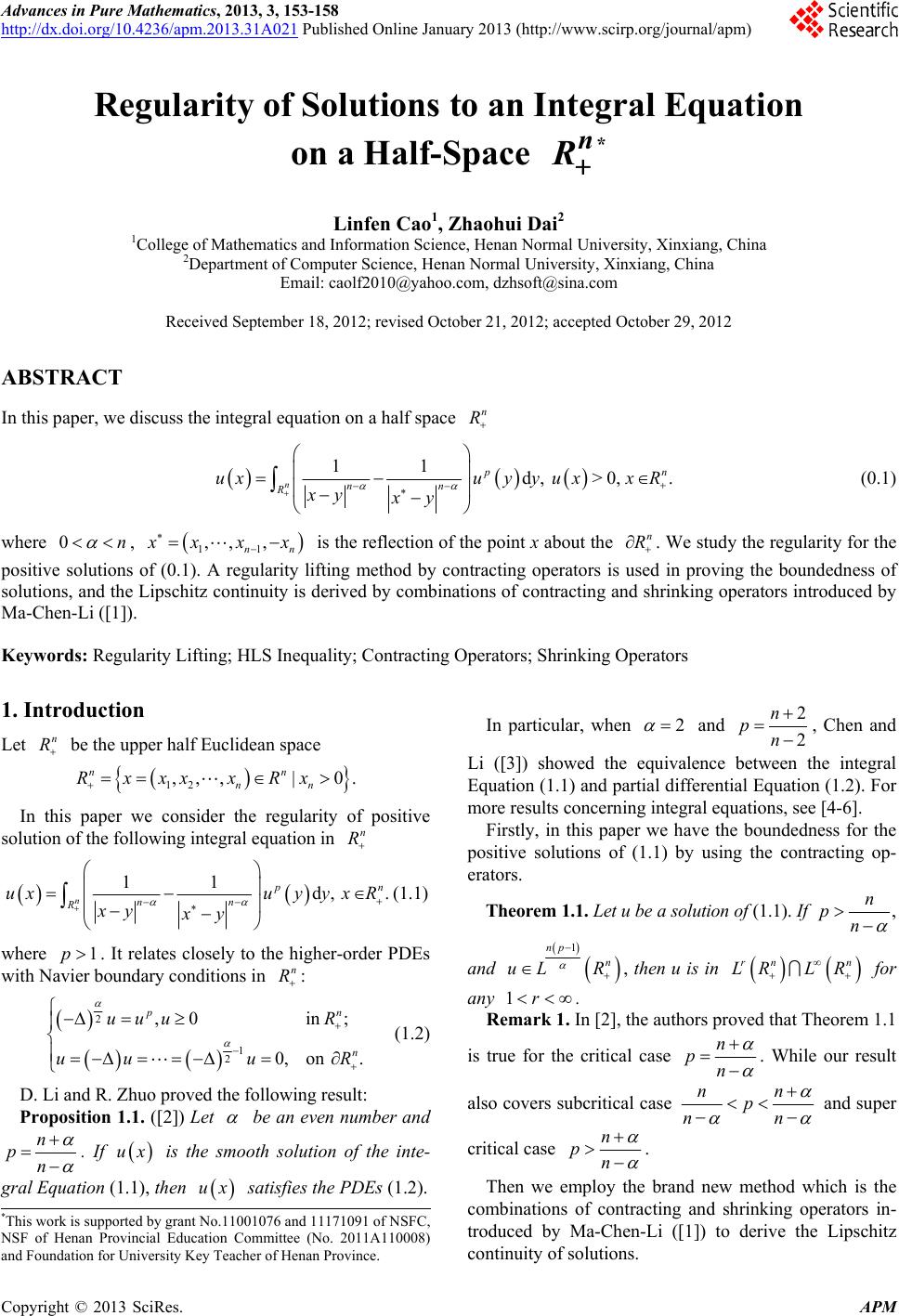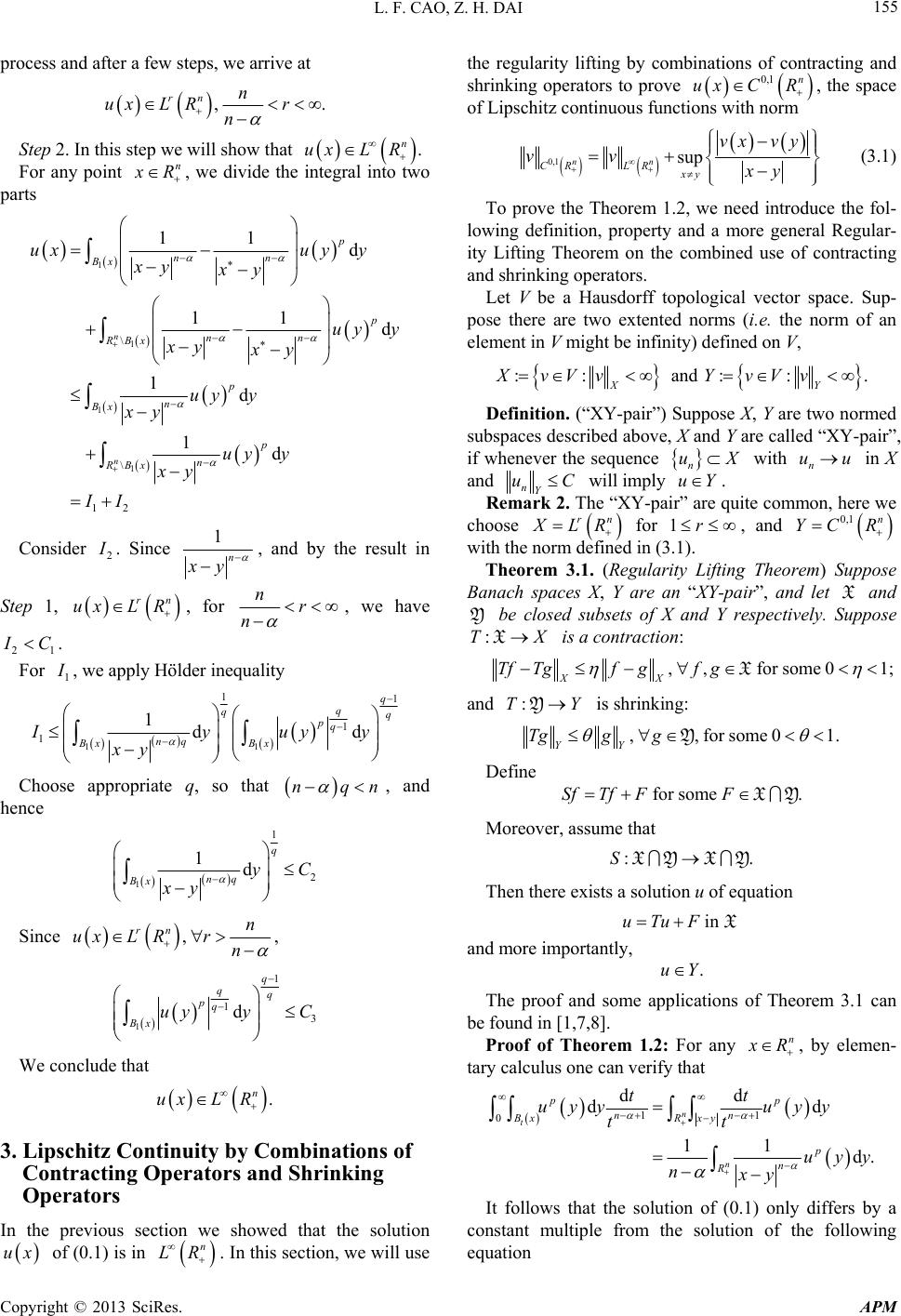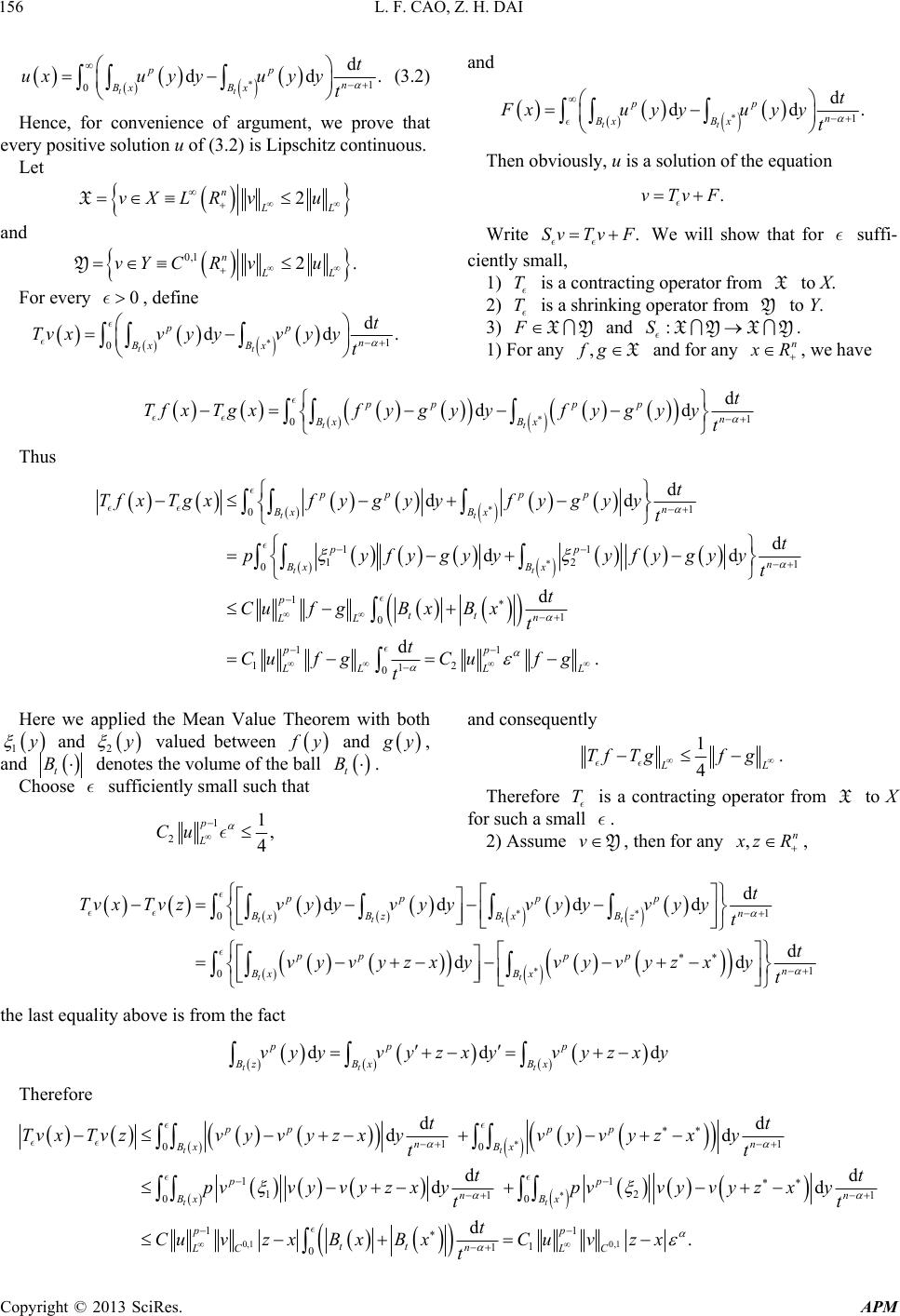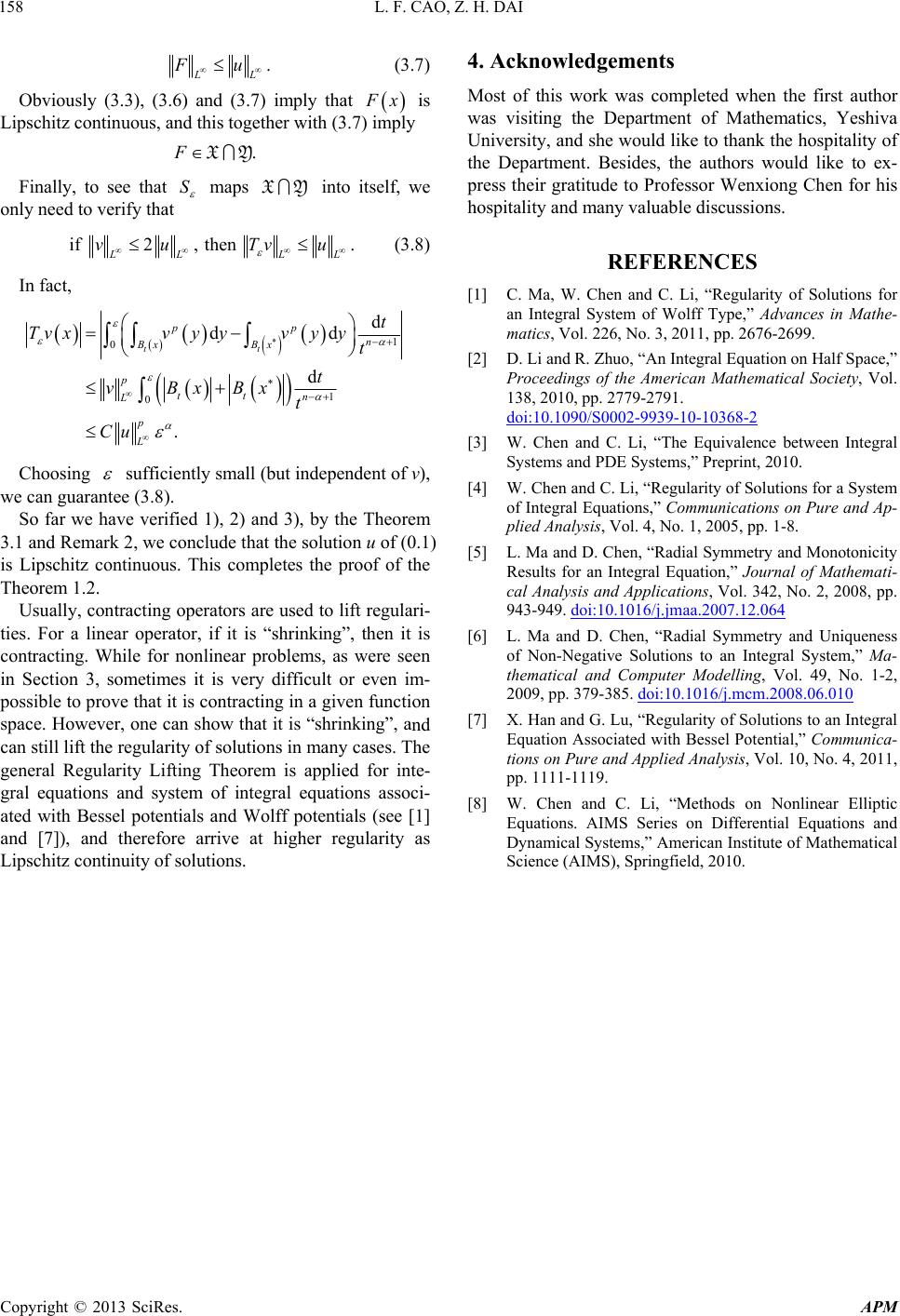Paper Menu >>
Journal Menu >>
 Advances in Pure Mathematics, 2013, 3, 153-158 http://dx.doi.org/10.4236/apm.2013.31A021 Published Online January 2013 (http://www.scirp.org/journal/apm) Regularity of Solutions to an Integral Equation on a Half-Space n R * Linfen Cao1, Zhaohui Dai2 1College of Mathematics and Information Science, Henan Normal University, Xinxiang, China 2Department of Comp u t e r Science, Henan Normal University, Xinxiang, China Email: caolf2010@yahoo.com, dzhsoft@sina.com Received September 18, 2012; revised October 21, 2012; accepted October 29, 2012 ABSTRACT n RIn this paper, we discuss the integral equation on a half space 11 d, n >0, . p n xx R nn R uxuy yu xy xy 0n (0.1) where 11 ,, , nn , xxx n R is the reflection of th e point x about the x . We study the regularity for the positive solutions of (0.1). A regularity lifting method by contracting operators is used in proving the boundedness of solutions, and the Lipschitz continuity is d erived by combinations of contracting and shrinking operators introduced by Ma-Che n-L i ( [ 1 ]). Keywords: Regularity Lifting; HLS Inequality; Contracting Operators; Shrinking Operators 1. Introduction Let be the upper half Euclidean space n R 12 ,,,| 0. nn nn Rxxx xRx n R In this paper we consider the regularity of positive solution of the following integral equation in 11 d, . npn nn R uxuyyx R xy xy 1pn R (1.1) where . It relates closely to the higher-order PDEs with Navier boundary conditions in : 2in; 0, on. pn n uu R uuu R 1 2 ,0u (1.2) D. Li and R. Zhuo proved the following result: Proposition 1.1. ([2]) Let be an even number and n pn ux 2 . If is the smooth solution of the inte- ux gral Equation (1.1), then satisfies the PDEs (1.2). In particular, when and 2 2 n pn , Chen and Li ([3]) showed the equivalence between the integral Equation (1.1) and partial differential Equation (1.2). For more results concerning integral equations, see [4-6]. Firstly, in this paper we have the boundedness for the positive solutions of (1.1) by using the contracting op- erators. Theorem 1.1. Let u be a solution of (1.1). If n pn , and 1np n uL R , then u is in rn n LR LR 1r for any . Remark 1. In [2], the authors prov ed that Theorem 1.1 is true for the critical case n pn . While our result also covers subcritical case nn p nn and super critical case n pn . Then we employ the brand new method which is the combinations of contracting and shrinking operators in- troduced by Ma-Chen-Li ([1]) to derive the Lipschitz continuity of solutions. *This work is supported by grant No.11001076 and 11171091 of NSFC, N SF of Henan Provincial Education Committee (No. 2011A110008) and Foundation for University Key T ea c h e r o f H en a n Prov i n c e. C opyright © 2013 SciRes. APM  L. F. CAO, Z. H. DAI 154 Theorem 1.2. Under the same conditions of Theorem 1.1, u is Lipschitz continuous in . n R L L 2. Estimate by Contracting Operators In this section, we obtain estimate for positive solu- tions to the equation (0.1) by using the contracting op- erators. To prove the Theorem 1.1, we need the follow- ing equivalent form of Hardy-Littlewood-Sobolev ine- quality. Lemma 2.1. Let nr n nr g LR for nr n . Define d. ng yy 1 n R Tg xxy (2.1) Then . nr n nr L R g rn 1r ,, rn LR TgC nr Proof of Theorem 1.1: The proof is divided into two steps. Step 1. We first show that , uxL R n, x R .ax ux . Define 1p Then d ayuy y 11 nnn R ux xy xy For a positive number A, defin e ,if 0, elsewher A ax ax ax ,or e. AxA . BA ax ax Let ax Obviously, B, and vanishes outside the ball ax A B ax 0 A B. Define d. yv yy 11 n AA nn R Tv xa xy xy d. 11 n AB nn R F xa xy xy yuyy . AA xF x 1r n The Equation (0.1) can be rewritten as ux Tu We will show that, for any , 1) TA is a contracting map from to r LR rn LR for A large, and rn LR 2) A F x is in . rn vLR 1) Assume , then 11 d. n AA nn R Tvayv yy xy xy For any n rn , we apply Hardy-Littlewood-Sobo- lev inequality and Hölder inequality to obtain . nr n rnnn rn nr AA A LRLRL RLR Tv CavCav Since nn axLR , by the definition of Axa , one can choose a large number A, such that 1. 2 nn ALR Ca and hence arrives at 1. 2 rn rn ALR LR Tv v :rn rn AR LRTL That is is a contracting op- erator. 2) Consider 11 d. n AB nn R xayuyy xy xy F For any n rn , we apply Hardy-Littlewood-Sobo- lev inequality and Hölder inequality to obtain . nr rnnsn tn nr AB B LRL RLRLR FCau Cau We require 11 ,, 1. nr st nrst By the bounded-ness of B a , we see that s can be arbitrary. Since 1np n uL R , we take 1np t , and hence 11 ,as , 12 2 np np rs np p p s we see 1 2 np p A FL 0, for any small . Obviously, 11 2 np np p 1p 2p2p since . If , we are done. If , repeat the above Copyright © 2013 SciRes. APM  L. F. CAO, Z. H. DAI 155 process and after a few steps, we arrive at ,. nr n rn ux L R Step 2. In this step we will show that . n L R nux For any point x R , we divide the integral into two parts 1 1 1 1 \ \ 12 11 11 1d 1d n n nn Bx nn RB x p n Bx p n RBx ux xy xy xy xy uyy xy uyy xy II d d p p uyy uyy Consider 2 I . Since 1 n xy n R , and by the result in Step 1, , for r ux Lnr n , we have 21 I C. For 1 I , we apply Hölder inequality 11 1 11q nq Bx Bx Iy xy 1 1 dd q qq pq uyy Choose appropriate q, so that nqn , and hence 1 1 Bx xy 1 2 dq nq yC Since ,n rn rn ux L R , 1 q pq Bxuy 1 13 d q q y C We conclude that . n L R ux n LR 0,1 n ux CR ux 3. Lipschitz Continuity by Combinations of Contracting Operators and Shrinking Operators In the previous section we showed that the solution of (0.1) is in . In this section, we will use the regularity lifting by combinations of contracting and shrinking operators to prove , the space of Lipschitz continuous functions with norm 0,1 sup nn CRLR xy vx vy vv xy (3.1) To prove the Theorem 1.2, we need introduce the fol- lowing definition, property and a more general Regular- ity Lifting Theorem on the combined use of contracting and shrinking operators. Let V be a Hausdorff topological vector space. Sup- pose there are two extented norms (i.e. the norm of an element in V might be infinity) defined on V, ::and:: . XY XvVvYvVv Definition. (“XY-pair”) Suppose X, Y are two normed subspaces described above, X and Y are called “XY-pair”, if whenever the sequence n uXn uu with in X and nY uC will imply . uY Remark 2. The “XY-pair” are quite common, here we choose rn 0,1 n RYC X LR r for 1, and X Y:TXX with the norm defined in (3.1). Theorem 3.1. (Regularity Lifting Theorem) Suppose Banach spaces X, Y are an “XY-pair”, and let and be closed subsets of X and Y respectively. Suppose is a contraction: ,,forsome0 1; XX TfTgfgf g X :TYY and is shrinking: ,,forsome01. YY Tggg Y for some. Sf Tf FF Define XY :.SXY XY inuTuF Moreover, assume that Then there exists a solution u of equation X .uY and more importantly, The proof and some applications of Theorem 3.1 can be found in [1,7,8]. n Proof of Theorem 1.2: For any x R , by elemen- tary calculus one can verify that 11 0 dd dd 11 d. n t n pp nn BxR xy p n R tt uyy uyy tt uyy nxy It follows that the solution of (0.1) only differs by a constant multiple from the solution of the following equation Copyright © 2013 SciRes. APM  L. F. CAO, Z. H. DAI APM 156 Copyright © 2013 SciRes. 1 d d. p n t y yt and 0d tt p Bx Bx ux uy yu (3.2) Hence, for convenience of argument, we prove that every positive solution u of (3.2) is Lipschitz continuous. Let 2 LL v u n vXLR X and 0,1 n vY CR Y2. LL v u 0 For every , define 1 d dd. n t yy t 0tt pp Bx Bx Tv xvy yv 1 d dd. tt pp n Bx Bx t Fxuy yuy yt .vTvF Then obviously , u is a solution of the equation .Sv Tv F Write TX TY F We will show that for suffi- ciently small, 1) is a contracting operator from to X. 2) is a shrinking operator from to Y. XY:SXYXY ,fg and . 3) 1) For any Xn and for any x R , we have 1 d dd tt pppp n Bx Bx t Tfx Tgxfyg yyfyg yyt 0 Thus 1 0 11 12 1 1 1 0 11 12 1 0 d dd d dd d d. tt tt ppppn Bx Bx pp n Bx Bx p tt n LL pp LLLL t TfxTg xfygyyfygyyt t pyfygy yyfygy yt t Cuf gBxBxt t Cu fgCufg t 0 and consequently Here we applied the Mean Value Theorem with both 1 y 2 y f y and valued between and g y , and t B denotes the volume of the ball t B . Choose sufficiently small such that 1 2, 4 p L Cu 1 1. 4 LL Tf Tgfg TX v Therefore is a contracting operator from to X for such a small . Y,n , then for any x 2) Assume zR , 1 0 1 0 d ddd d d dd ttt t tt ppp p n Bx BzBxBz pppp n Bx Bx t TvxTvzvyy vyyvyyvyyt t vyvyzxyvyvyz xyt the last equality above is from the fact ddd tt t pp p Bz BxBx vyy vyzxyvyzxy Therefore 0,1 0,1 11 00 1 1 1 2 1 1 00 1 1 1 1 0 dd dd dd dd d. t t t t pp nn Bx Bx p p n n Bx Bx p p tt n LC LC tt TvxTvzzxyvyvyz xy tt tt pvvy vyzxypvvyvyzxy tt t CuvzxB xBxCuvzx t pp vyvy  L. F. CAO, Z. H. DAI 157 Again choosing sufficiently small, we derive by 0,1 1. 4C zv Combining this with the estimate in 1), we arrive at sup xz Tv xTv zx 0,1 0,1 1,. 2 CC TvvvY Hence T is a shrinking rator from Y to Y. 3) To show F is Lipschitz continuous, we split it into two parts: ope tt Ix Ix 1 1 1 1 12 d dd d dd tt pp n Bx Bx pp n Bx Bx t Fxuy yuy yt t uyyuyy t For the first part, we have 1 11 d tt pp Bx Bz Ix Izu yyu 1 111 1 1 d dd d d1. t t p p n Bx Bz pp nn LL t yyuyyu yy t t CutxzxzCuxz t useHere wed the fact that 1 the volume of\\. n tt tt Bx BzBz BxCtxz It follows that 11 . sup IxIzC (3.3) xz xz For the second part, we use a different approach. Write x z , then 11 1 33 d ddd d ,, ttt t ppp p n Bx BzBzBx t Izuyyu yyu yyu yy t Ixz Izx 1 Ix 11 11 1 111 1 d d dd d d1dd11 1d1 t t ttt p n B zBz n n ppp nn n BzBz Bz p n yz t u uyy tt t uyyuyy uyy tt t uyy yz 12 d. np R Cuyy C (3.4) Similarly, 1 n 1 31 11 d ,dd d tt pp p n Bx Bz t Ixzuyyuyyyy tt 1 311 11 dd ,dd dd tt t t pp pp nn BzBxB xBx tt Izxuyy uyyuyy uyy tt 11 11 1 11 dd d1 d dd d11 d tt t t n pp nn Bx Bx n pp nn Bx Bx tt uy y uyy tt tt uyy uyy tt 1 23 11nC (3.5) Note that here we applied the Mean Value Theorem with both 1 fore, and 2 valued between 0 and . Combining (3.4) and (3.5), we have 223 3 ,, I xIz IxzIzxC The same inequality holds for 22 I zIx. There- 22 . sup xz Ix IzC xz Also from the definition of (3.6) F x, we immediately have Copyright © 2013 SciRes. APM  L. F. CAO, Z. H. DAI 158 .Fu (3.7) y ( LL Obviousl (3.3), 3.6) and (3.7) imply that F x is Li ith (3 ipschitz continuous, and this together w.7)mply .FXY Finally, to see that S maps XY tself, we only need to verify that into i if2, then LL . L vu Tvu (3.8) In fact, L 1 0tt n Bx Bx p vt vBxBx 1 0 . tt n L p L t Cu d dd pp t Tvxvy yy y dt Choosing sufficiently smallut independent of v), w 1), 2) and 3), by the The 3.1 and Remark 2, we conclude that the solutio is Lipschitz continuous. This completes the pro Th. Usually, contracting operators are used to lift reg ties. For a linear operator, if it is “shrinking”, then it is contracting. While for nonlinear problems, as were seen in Section 3, sometimes it is very difficult or even im- possible to prove that it is contracting in a given functio space. However, one can show that it is “shrinking”, a can still lift the regularity of solutions in many cases. The ge la 4. Acknowledgements enxiong Chen for his discussions. Society, Vol. 138, 2010, pp. 2779-2791. doi:10.1090/S (b e can guarantee (3.8). So far we have verifiedorem n u of (0.1) of of the eorem 1.2ulari- n nd neral Regurity Lifting Theorem is applied for inte- gral equations and system of integral equations associ- ated with Bessel potentials and Wolff potentials (see [1] and [7]), and therefore arrive at higher regularity as Lipschitz continuity of solutions. Most of this work was completed when the first author was visiting the Department of Mathematics, Yeshiva University, and she would like to thank the hospitality of the Department. Besides, the authors would like to ex- press their gratitude to Professor W hospitality and many valuable REFERENCES [1] C. Ma, W. Chen and C. Li, “Regularity of Solutions for an Integral System of Wolff Type,” Advances in Mathe- matics, Vol. 226, No. 3, 2011, pp. 2676-2699. [2] D. Li and R. Zhuo, “An Integral Equation on Half Space,” Proceedings of the American Mathematical 0002-9939-10-10368-2 [3] W. Chen and C. Li, “The Equivalence between Integral Systems and PDE Systems,” Preprint, 2010. [4] W. Chen and C. Li, “Regularity of Solutions for a System rnal of Mathemati- of Integral Equations,” Communications on Pure and Ap- plied Analysis, Vol. 4, No. 1, 2005, pp. 1-8. [5] L. Ma and D. Chen, “Radial Symmetry and Monotonicity Results for an Integral Equation,” Jou cal Analysis and Applications, Vol. 342, No. 2, 2008, pp. 943-949. doi:10.1016/j.jmaa.2007.12.064 [6] L. Ma and D. Chen, “Radial Symmetry and Uniqueness of Non-Negative Solutions to an Integral System,” Ma- thematical and Computer Modelling, Vol. 49, No. 1-2, 2009, pp. 379-385. doi:10.1016/j.mcm.2008.06.010 [7] X. Han and G. Lu, “Regularity of Solutions to an Integral Equation Associated with Bessel Potential,” Communica- tions on Pure and Applied Analysis, Vol. 10, No. 4, 2011, pp. 1111-1119. [8] W. Chen and C. Li, “Methods on Nonlinear Elliptic Equations. AIMS Series on Differential Equations and Dynamical Systems,” American Institute of Mathematical Science (AIMS), Springfield, 2010. Copyright © 2013 SciRes. APM |

